How to Grow Sweet Tomatoes
The taste of tomatoes depends on the variety. For example, “Chumak” or “Slivki” are used for rolling - they have elastic skin and dense flesh. But first-class sugar varieties, such as “Bull’s Heart”, “Persimmon”, “Black Prince”, have the qualities of sugar tenderness and increased juiciness. But the taste depends not only on the variety. Certain soil care for tomatoes affects the biochemical structure and taste characteristics of the fruit.
Our article is about how to grow sweet tomatoes.
Preparing the seat
For growing tomatoes, choose the south-eastern or south-western sides of the plots. Tomatoes give a good harvest if they are planted near the southern walls of buildings or a fence. You can grow tomatoes in one place for several years in a row, but then the soil should be treated with organic fertilizers before planting.
Ideally, the predecessors of the crop were cabbage, onions, cucumbers, zucchini and corn. But it is not advisable to grow tomatoes after physalis, peppers, eggplants and potatoes. If these crops were cultivated on the site, then tomatoes should be planted after three years. In the worst case, the plant will get sick. It is also not advisable to plant tomatoes after potatoes or close to them, so that the plants are not subject to late blight.
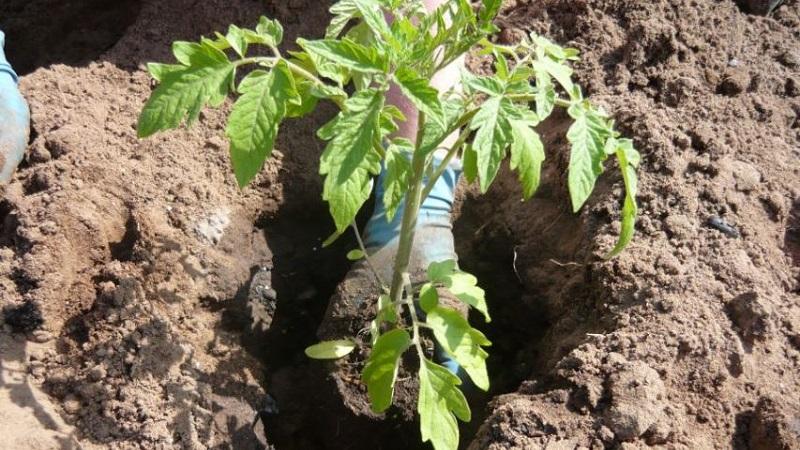
The soil must be loosened and humus, sawdust, straw or peat added to it, one bucket per 1.2 m. Turf soil or humus is added to peaty soil. In order for the finished beds to warm up, they are covered with black film.
They prepare the soil for planting tomatoes in the fall. When the acidity of the soil is increased, the following is added with autumn digging:
- 0.5–0.9 kg of lime;
- 40–60 g superphosphate;
- 4-6 kg of organic fertilizers (manure, bird droppings, compost or peat are suitable).
Reference. If such methods were carried out with previous crops, then the area for growing tomatoes only needs to be dug up.
When cultivating the soil in spring, it is necessary to apply 30 g of potassium fertilizers per 1–2 m of land., as well as 30–50 g of superphosphate. Before the last loosening, the soil is fertilized directly under planting with 20 g of potassium and 30 g of nitrogen components.
Selection and planting of tomato seedlings in the ground
Hybrid types of tomatoes are chosen for growing in greenhouse conditionsbecause they are disease resistant. In determinate or semi-determinate plants, growth is limited, and they are formed in 4-5 clusters on one stem; their active life spans up to four months.
Tomatoes are planted in a greenhouse in the first half of May in warm soil. (at a depth of twenty centimeters, the ground temperature should be more than 13 degrees) when the height of the stem reaches 30 cm. At this age, plants easily tolerate temperature changes and replanting. Tall varieties are planted in rows at a distance of 50 cm, and medium-sized ones - 40 cm or in a checkerboard pattern.
Seedlings are planted vertically. As plants grow, they are laid at an angle and tear off the lower leaves, covering them with earth.
Holes for growing tomatoes are treated in the following way: dilute manganese with water in a ratio of 1 g/10 l in buckets and water the soil using complex organomineral fertilizer. For rooting, tomatoes are not watered for two weeks after planting. Then water it at the root.When watering, you need to protect the leaves from moisture so as not to expose the plant to infection.
Good to know:
How to water tomatoes in open ground
How to grow tomatoes in open ground? Watering and fertilizing are two important aspects in the growth process.
The bushes are watered at intervals of 4 days. If the weather is dry, then more often. The main thing is not to overdo it, so that the fleshiness and sugar content of the tomatoes do not decrease and they do not become watery and sour.
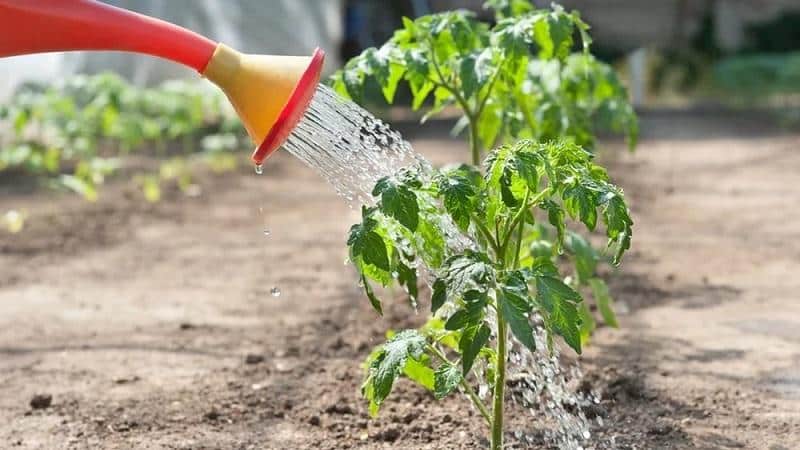
Water tomatoes in the evening, when the air temperature drops. On hot days - 2-3 hours before sunset. You can also water in the morning, but with warm water - at least 20°C.
To determine if the soil is well watered, take a lump of earth from a 10-centimeter depth and shake it in your hand. If the soil is easy to mold and disintegrate, then the soil is moist enough.
You can use the drip subsoil method of watering tomatoes in open ground.. This watering is done using plastic bottles. 2-4 holes with a diameter of no more than 2 mm are made in the lids with a nail.
Attention! The number and size of holes in the bottles depend on the composition of the soil. Sandy soil will require 2-3 holes, and clay soil - 3-4.
It is better to buy pegs in a special store. They are placed on the neck of the bottles, thereby reducing the possibility of damage to the roots when placed in the ground. Bottles have their bottoms cut off. Containers are dug into the hole to a depth of no more than 15 centimeters, with a 15-centimeter distance from the plant, at a 35-degree inclination with the cork down. During watering, the bottles are filled with water. With the required number of holes, the water leaves gradually.
If water is absorbed immediately when filling bottles, you should adjust the diameter and number of holes to suit the composition of the soil. With this method, water immediately flows to the roots, moisture does not evaporate, and the risk of developing infectious diseases is prevented. You can also use this device to fertilize plants with a nutrient solution.
If you are watering with a hose, remember to pour water at the root, but do not erode the soil. Water carefully so that water does not get on the leaves and fruits, because drops that do not dry on the tops can cause sunburn. With this method of watering, the temperature of the soil and air decreases, which leads to the falling of flowers and a delay in the formation of ovaries and fruits. A sharp increase in moisture in the air is the cause of fungal diseases.
Since tomatoes are heat-loving plants, it is difficult for them to tolerate watering with cold and hard tap water. Tomatoes are watered with warm rain. You can also wait for tap water to settle and pour it over. To make the irrigation liquid softer, add manure, compost or weeds. For joint watering, fertilizing and protection from diseases, add ash to the water - 1-2 pinches per 10 liters.
After rains, it is advisable to loosen the soil. To bypass this procedure, the soil is mulched with mowed grass. One low-growing bush will need an average of 3-4 liters of water, and a tall bush will need about 6-8 liters per watering.
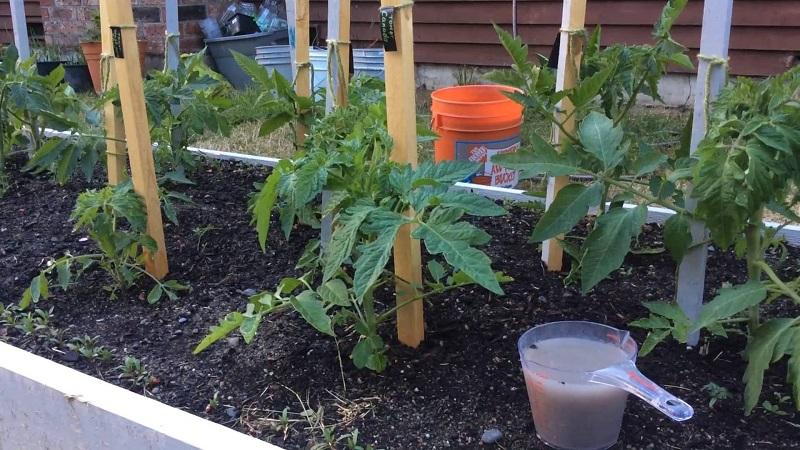
Feeding tomatoes in open ground
7 days after the tomatoes have found a new place, they need to be fed with fertilizer: Mix half a liter of liquid mullein with a bucket of water and add 1 tbsp. l. "Nitrofoski". Water at a rate of half a liter of nutrient liquid per bush.You can replace this fertilizer with the following solution: dilute one tablespoon of liquid “Ideal” with 10 liters of water and add the same amount of “Nitrophoska”. One plant will need 0.5 liters of solution.
When the second flower cluster begins to bloom, use the following solution: Stir half a liter of chicken droppings in a bucket of water. Add 1 tbsp. l. superphosphate and 2 times less potassium sulfate. Mix everything well, water at a rate of 1 liter of liquid per bush.
When blooming the third flower brush, use the following solution: dilute one tablespoon of potassium humate in ten liters of water (sodium humate or Ideal fertilizer in the same proportion is also suitable). Fertilizer consumption – 5 liters per 1 sq. m.
After fruit set, tomatoes are fed with the following solution: 1 tablespoon of superphosphate is stirred in 10 liters of water. For 1 sq. m. use 10 liters of solution.
To form a large number of tasty and fleshy tomatoes, plants need elements such as potassium, manganese, iodine and boron. In the absence of these substances, use mineral fertilizers with microelements or prepare your own fertilizer. To do this, stir 10 g of boric acid, 10 mg of iodine in 10 liters of water and add 1.5 liters of sifted ash. After mixing well, water each plant with 1 liter of the mixture.
Attention! Remember that boric acid will not dissolve in cool water. Pour a small amount of boiling water over it, then pour the mixture into a container of water.
Why do you need foliar feeding of tomatoes?
By foliar feeding we mean spraying the leaves. This feeding of tomatoes accelerates the setting and formation of fruits. The foliar method is used when the plants are flowering.
At the initial flowering of the clusters, spray the tomatoes with a 0.5% superphosphate extract. To prepare the extract, add 50 g of superphosphate to 10 liters of water and mix well twice. Leave the solution for a day, before use, strain the resulting mixture and apply 10 ml of fertilizer to each young bush, and as the plants grow, increase the dose by one and a half times.
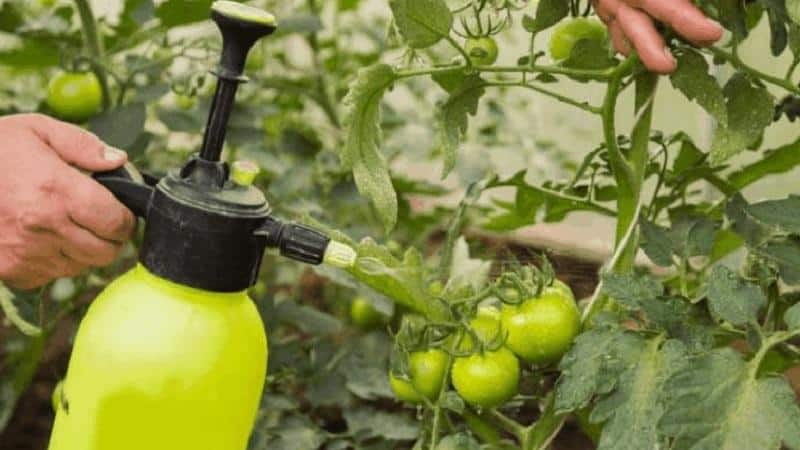
Another method of foliar feeding: add 1 tablespoon of urea and the same amount of Ideal fertilizer to 10 liters of water, stir well and treat the leaves with the solution.
Feeding correctly
The best time to feed is morning or evening. The weather should be dry and cool. The culture is nourished simultaneously with watering. To ensure that nutrients are distributed evenly, the types of feeding alternate (root or foliar).
Fertilizing based on potassium or phosphorus is used throughout the growing season. and during autumn tillage. Nitrogen-based fertilizing - only in spring. The main thing is not to overdo it with the dosage of nitrogen, otherwise the stems and leaves will grow rapidly, but not the fruits.
It will be interesting:
How to spray tomatoes against diseases and pests in summer
Tomato bushes are susceptible to blackleg disease. To prevent disease, change the soil before planting tomatoes.
Another common tomato pathology is late blight. To avoid illness three times per season carry out preventive treatment with the following solutions:
- fungicide "Zaslon" (1 cap per 300 g of liquid);
- fungicide "Barrier" (5 tablespoons per 10 liters of water);
- garlic infusion.
How to feed tomatoes with boric acid to protect them from late blight
Late blight and other fungal diseases often take people by surprise. To avoid infection, tomatoes are treated with folk remedies - boric acid, potassium permanganate and iodine. When ovaries form, spray the plants with a weak pink manganese solution. After a week, go through a solution of boric acid (1 teaspoon per 10 liters of water). After another week, treat the tops with a mixture of iodine (1 teaspoon per 10 liters of water).
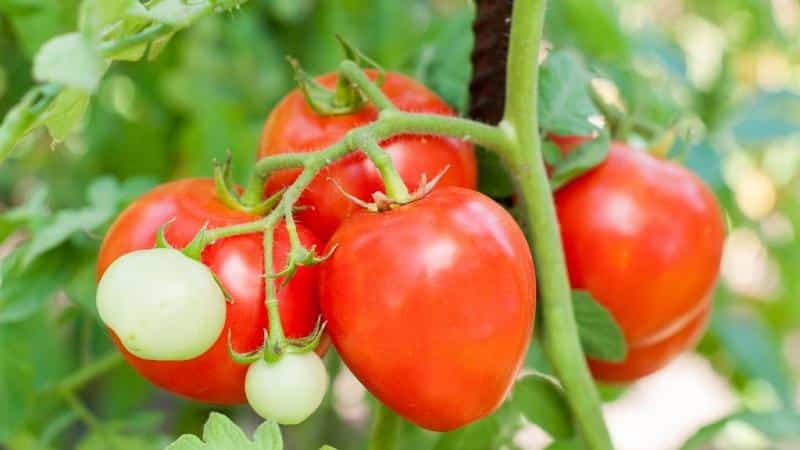
Harvesting
How and how long tomatoes grow depends on the variety of tomatoes, their growing conditions, climate, frequency of watering and amount of fertilizing.
Harvest at different levels of maturity of tomatoes - milk, green, red, brown-pink. It all depends on the purpose for which they will be used. Red tomatoes are chosen to make tomato juice, ketchup or tomato paste. Brown tomatoes are good for canning. And to store or leave to ripen, tomatoes are picked while they are still green or milky.
Unripe tomatoes (brown or milky) tear off and place in several layers in a box, covering each layer with paper. You should not store tomatoes in bags, as vegetables spoil quickly in such containers.
Reference. To speed up ripening, add several ripe ones to green tomatoes.
Conclusion
Tomatoes will grow sweet if you adhere to certain planting conditions - such as light, proper proximity and fertilizer. If you follow all the rules, your efforts will be rewarded with a rich and high-quality harvest.